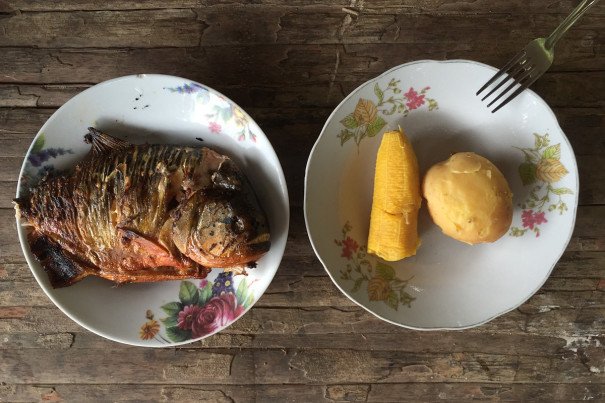
Settling Into a Routine of Killer Fish for Breakfast

Settling Into a Routine of Killer Fish for Breakfast
Piranha in the Pacaya-Samiria National Reserve
We found three of them one morning, twisting to swim free of the net we’d drawn, like a curtain, along the opening of the river cove the night before.
It was the eighth day of my ten-day canoe journey in Peru’s Northern Amazon, and this was the first time we’d caught piranhas. On the makeshift grill of our hut on stilts, half swallowed up by the swollen river this rainy season, my guide, Santiago, and his wife, Maritza, made quick work of the red- and yellow-bellied creatures. But even grilled to a crisp and served on porcelain plates with boiled plantains and potatoes, they still looked menacing. Everyone expects the taste of piranha to live up to its fearsome reputation, but it tastes like the fish we commonly eat and is surprisingly tender. It just has bigger teeth, which give it that pugnacious underbite, and which we admired before tucking in.
Later, Santiago showed me a C-shaped scar on his calf. “A piranha bit me once when I was wading around in the river. A piece of my flesh came loose,” he said.
I wanted to know: Did the piranhas swarm toward him? Are they really attracted to blood? Are they really carnivores?
“It’s not like in the movies,” Santiago said, laughing.
However, that’s not to say Santiago doesn’t believe in any of the tales surrounding this area. As a Cocama tribesman who has lived all his life in the jungle, he believes completely and seriously in Chullachaqui, the shapeshifting spiritual guardian of the Amazon animal kingdom. During long days on the river when there was nothing to do but paddle and talk, Santiago would tell me many seemingly impossible stories.
There was the giant caiman—25 feet long—which sent a big wave through the river and flipped a canoe into its mouth with its tail, or the local man who battled a jaguar with his bare hands and lost a leg, or the Pozo Galicia, a water well at least 100 feet deep that harbors the most monstrous creatures in the Amazon, including the anaconda. But as soon as I asked about the possible perils in us seeking out caimans, or about the mewling sound I heard in the middle of the night (which Santiago informed me was a baby puma, which meant mama puma was near), or the fact that we had no line of communication to the tour agency’s headquarters were something unfortunate to happen, I would be placated with the assurance that, “Don’t worry, everything will be fine.”
Of course, it was just ten days. And in those ten days, we had settled into something of a routine, which is not a word I would have ever used to describe the Amazon when it existed only in my imagination. We would wake up by dawn every morning, have breakfast, load up the canoe and spend most of the day paddling to our next stop, taking our lunch in between. When we arrived, we would set up camp, have dinner, and get to bed at about the same hour the frogs start their croaking symphony. And we ate fish every day for breakfast and lunch—the heaviest meals of the day here.
In retrospect, however, and in light of those stories that have stuck with me, I’ve started to see these routines more as rituals: an adherence to a certain invisible order.
In any case, mealtimes were never dull. How could they be, with piranha on the menu? Santiago and Maritza had also taught me the many ways to eat a fish here: grilled, fried, as soup, as stew, or wrapped in jungle leaves for extra fragrance—always thrown in with the local comeno seasoning, or ajinomoto, partly to offset the zing of the fish, which we would rub in salt when we caught them to keep them fresh. All in all, the worst thing to happen to me in the Amazon were the dozens of mosquito bites covering my body.